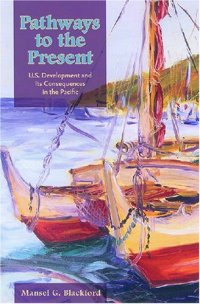
Ebook: Pathways to the Present: U.s. Development and Its Consequences in the Pacific (History)
Author: Mansel G. Blackford
Ranging from the Hawaiian Archipelago to the Aleutian Islands, from Silicon Valley to Guam, Pathways to the Present is a thoroughly researched and concisely argued account of economic and environmental change in the postwar "American" Pacific. Following a brief survey of the history of the Pacific, the author takes the Hawaiian Islands as the center of American activities in the region and looks at interactions among native Hawaiian, developmental, military, and environmental issues in the archipelago after World War II. He especially considers land-use matters on the island of Kaho`olawe, which had been used as a bombing range by the U.S. Navy until 1990 and has since been partially restored by native Hawaiian groups. The chapter closes with a comparison of developments on Kaho`olawe to conflicts with other naval live-fire ranges in the Pacific and the Caribbean.The author turns to land- and water-use problems that have intersected with more nebulous quality-of-life concerns to generate policy controversies in the Seattle region and the San Francisco Bay area, especially Silicon Valley. He goes on to compare high-tech districts in these areas with similar technology districts in South Korea and the Hawaiian Islands. Economic expansion and environmentalism in Alaska are examined through the lens of changes occurring along the Aleutians. From there the study considers Hiroshima after its destruction by the atomic bomb in 1945, looking at residents' desire to combine urban-planning concepts, including environmental-protection measures, with economic development. The author investigates the effort to remake Hiroshima as a high-tech city in the 1990s, an attempt inspired by the perceived success of Silicon Valley, and postwar planning on Okinawa, where American influences were particularly strong. The final chapter takes into account issues raised on Guam regarding the growth of tourism and the use of the island for military purposes and links these to developments in the Philippines to the west and American S?moa to the south.The stories told here reveal how and why individuals and groups of people, especially indigenous peoples, acted to influence their economic, social, and physical environments and the consequences of those actions. Thus Pathways to the Present contributes in important ways to environmental, business, and economic history and to Pacific history. It looks beyond Oceania to the North Pacific to paint a thought-provoking picture of broad regional growth, which greatly increases our understanding of why the Pacific is the way it is today.
Download the book Pathways to the Present: U.s. Development and Its Consequences in the Pacific (History) for free or read online
Continue reading on any device:

Last viewed books
Related books
{related-news}
Comments (0)